As gamers are fond of saying—and we have been since the early 80s—sometimes the dice just know. Whether it’s rolling the critical hit or the critical fumble at the dramatically appropriate moment, we like to believe there is some external force looking after our games. Who’s to say there isn’t? Just like with the dice, sometimes the gods of numbers line up in our favor. So it has with the Commander 2015 decks and my Monday Night Gamers: five of them and five of us.
Those of you who have been following along with my educational exploits know that this past semester was my most challenging yet. I carried sixteen credits, one of which was a graduate course (I’m in a program in which I’m basically an undergrad and graduate student at the same time). One of those classes was Beginning Italian. During one of the speaking tests, the question was “Di solito, che cosa fai nel tempo libero?” (Usually, “what do you do with your free time?”). My answer was “No ho il tempero libero. Sono uno studente di dottorato.” (I don’t have free time. I’m a graduate student). Other than playing in Atlanta, I haven’t picked up a deck since August, which is basically forever in Commander terms. What’s that mean to you? It means that I’m chomping at the bit to get some games in (and why you haven’t seen a play-by-play in a while). I miss our favorite format and intend to spend a great deal of time over the Christmas break playing games and talking about the format with you all.
First up is our Commander 2015 Mini-League. It’s mini because there are only the five of us, all of whom you have met during the many adventures on these very pages: Keith, Todd, Michael, and Shea. The idea of the League is pretty simple: start with the decks straight out of the box, play games, then provide a method of slowly updating the decks: no more than 1-3 cards per game. We’re still working through some of the specifics, but I’ll give you what we have.
Overarching ideas
· Decks not updated too quickly
· Decks updated at a somewhat equal pace for everyone
· League singleton
· Points based on more than raw kills
· Have fun
We want to play with these decks in the spirit of how they came out of the box. That means continuing the theme of the deck and not just wiping it to and making goodstuff.dec. It also means having an upper limit of how many changes we’ll make. Again, we haven’t settled on specifics, but something in the neighborhood of 50% seems right, so the deck will always have at least 50 of its original cards (unless we decide to not include basic lands in that count). In whatever fashion the individual player wants to make that happen is up to them, whether it’s making the creature based into a complete tribal theme, eventually getting rid of all the stuff which costs too much, or updating the manabase.
One of the things I’ve discovered in closed leagues with mechanisms which add cards (like Sealed Deck ante leagues) is that the person who gets ahead first goes on to dominate. We want to smooth that out some. To that end, each time we play, everyone will have the opportunity to update their deck, with the aforementioned 1-3 cards. We’re leaning toward 1-2 right now, with not the numbers of cards updated being important, but the order you get to pick them (more on that in a moment. Realistically 2-3 should also be fine, especially with an upper cap on how many you can change. If the baseline each game is 2, with one person getting 3, your average update is 2.2—which means 20 games with the decks under our belts before you start hitting your head on the top. Of course, after later games, you can still update them, but at that point you’ll be taking out stuff you’ve put in previously (or maybe putting back something original) in order to keep with the limit. It creates a whole new realm of strategy.
One of the unique features will be making all new cards introduced into the League true singletons—meaning if the card is already in someone else’s deck, whether due to an update or being part of the original list, you can’t choose it. This can make pick order extremely important, as you might want to cut off a particularly good card from one of your adversaries—although we’ll institute a rule that there’s no hate drafting. The Simic deck can’t choose Damnation just to get it out of the pile. Obviously, there are some cards which work only in some decks, so you don’t have to worry about being cut out of some things. For example, only the Simic deck can play Edric, Spymaster of Trest, while two of the five can play blue cards and green cards. You’ll probably end up competing with one other person for mono-colored cards, and everyone for artifacts and colorless things. It’ll be interesting to see if anyone goes for an Eldrazi with an early pick. I know that some of the decks have a few of the same cards in them. While it’d be more interesting if that wasn’t the case, there aren’t so many of them as to matter. Maybe we can institute a pick bonus for getting rid of a card which exists in multiples in the original decks. Would you swap out Sol Ring for a bonus pick? Tough questions must be answered.
In the beginning, we discussed making card lists to draft from. We went down a whole list of variants and other crazy things, then realized we were doing way too much work for too little reward. Good systems are also streamlined systems. We don’t want to focus too much on the administrative end. After all, the idea is to play the decks and have fun with them. Having a closed list from which to pick—maybe 50 cards of each color (and colorless/artifact) might be interesting enough to think about. It would pretty easy for each player in a color to pick 25 cards; if people pick duplicates, either pick some new ones or just leave the list a little shorter—another strategic decision to make. Maybe have a limited number of two-color cards on the list. See how complicated you can make this? It’s a fun thought exercise, but then you spend all your time doing something other than playing.
When you’re competing for cards, pick order becomes significant. That’s why basing the points (or pick order) coming out of each game makes it more significant. Our current working model had first pick after a game go to the first person eliminated (although you can’t eliminate yourself without also killing someone else, like via Hurricane). Second pick is whoever got the first kill. Once you get a point, you can only get the bonus point for last person standing; third, fourth, and fifth picks are still a matter of question—although it’s clear that fifth pick goes to the person who doesn’t yet have a point. I considered something a little more portable for picks 3 and 4—like 3 going to the person who died with the highest life total before lethal damage (who doesn’t already have a point) and 4 being the person with the lowest. Any suggestions on those middle points—which aren’t overly complicated or math-y—are welcome. It just now occurs to me that we can somehow leverage the experience counter mechanic—so the next picks go in either ascending or descending order of the number you have (probably descending).
The second set of available points comes from a bounty system. Before each game, everyone is secretly given a card with the name of one of the players on it. You can get yourself. When your bounty gets killed, you reveal it and get a point. First bounty collected goes to the top of second round pick order. The person who doesn’t collect a bounty gets the last pick of round two. We could probably add a strategic layer in that you only get the point if you kill your bounty. This might lead to snatching points away from people (at least temporarily) by saving whomever they’re targeting. It will create an interesting balance between aggression and defense. Adding some depth is better than just telegraphing “oh, I need to kill Todd this game.” We might also use the bounty system to tally league points. Everyone will get a pick from round 2 based on the order in which people died regardless of who did the killing, but get a league point (redeemable for something?) only if you do the actual killing of your target. This adds an additional layer of strategy in being able to once again take kills away from people, either by saving the target or killing them yourself. League points become redeemable when you’ve built up a number of them—multiples of three or five or whatever. We could make an ascending list of accomplishments which are basically replacements that don’t cost you anything, something like:
Threshold 1: Replace a basic land with the nonbasic land of your choice
Threshold 2: Replace a common card with an uncommon card of the same mana cost
Threshold 3: Replace a common or uncommon card with a rare card of the same converted mana cost
Threshold 4: Replace a rare card with a mythic rare card
We could also use the thresholds to limit what cards get picked (as opposed to making pick lists, an idea I’m starting to come around on a little).
Threshold 0: You may only choose common cards for your replacements
Threshold 1: You may choose common or uncommon cards for your replacements
Threshold 2: You may choose common, uncommon, or rare cards for your replacements
Threshold 3: You may choose any cards for your replacements
This could lead to a cascade effect in single card slots. For example, I have the Ezuri, Claw of Progress deck. I’m not a fan of Orochi Hatchery. My first replacement is taking it out and putting in Fog. When I can upgrade in that slot, I put in Tangle. I already have Arachnogenesis, so boom.
Alternately, thresholds could be used in this fashion:
Threshold 0: Your replacements must be cards of the same mana cost
Threshold 1: Your replacements must be cards of the same converted mana cost
Threshold 2: Your replacements must be cards of the same or lower converted mana cost
Threshold 3: Your replacements may be cards of any converted mana cost
You can see that we could go down lots of roads with all the variations. Most of these are pretty simple; it wouldn’t take much to get hideously complex. These would require a minimal amount of bookkeeping, another thing I don’t want to have to do too much of.
Pick Lists
As I’ve mentioned, pick lists might be over the tipping point—but it’s still an idea worth exploring, at least for the mental exercise. Closed sets become very interesting strategically. Suddenly the Commander 2015 League becomes more like a fantasy football draft, since once a card goes out of a deck, it goes onto the waiver wire.
The only thing that makes sense is that the people in each color come up with the lists for their colors. Otherwise, they become lists full of Sorrow’s Path or One with Nothing. The tricky part is that I know I’m sharing a list with another person. I have to put cards on it that I want, but I have to realize they can pick them as well. There would have to be a limited number of multi-colored cards one can put on the list, which would prevent me filling mine with only U/G cards. Alternately, we are only allowed to put mono-colored cards on the list, and then use thresholds to be able to pick multi-colored cards, either from a different list or just from all the cards there are (since such a list is just the 10 or 25 best cards in that color combination).
Here’s a quick sample of what I came up with off the top of my head to put on my list. There are 30 cards here with a limited number of multi-colored ones:
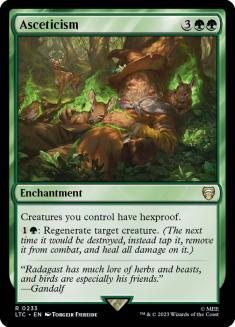
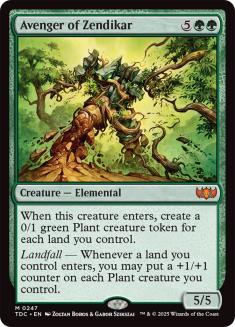
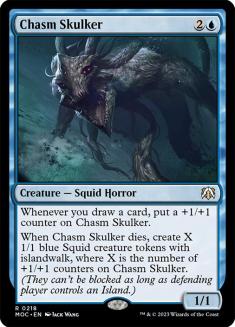
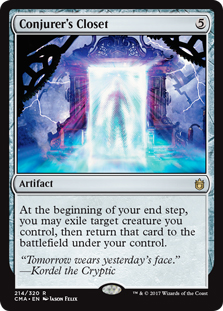
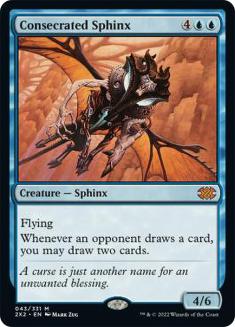
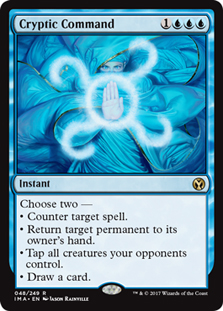
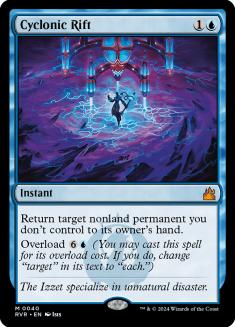
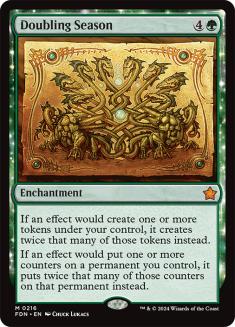
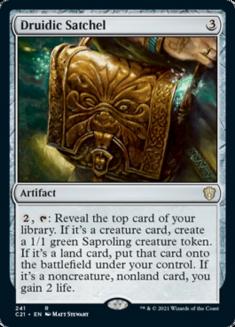
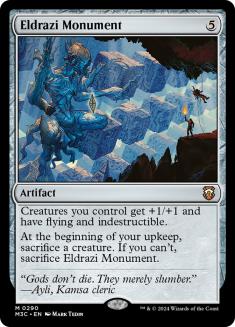
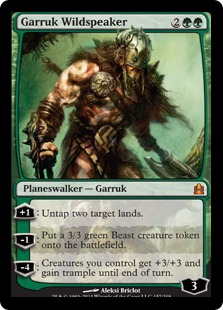
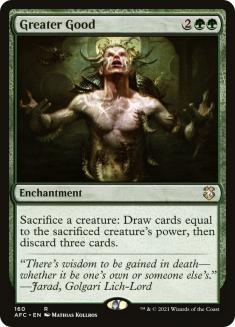
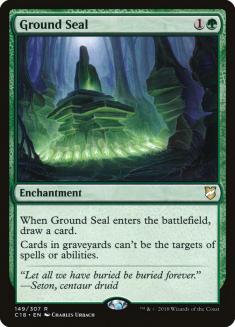
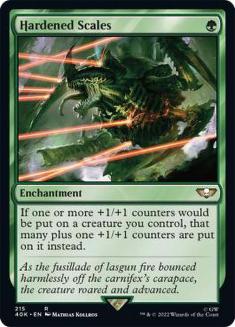
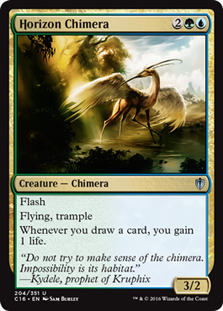
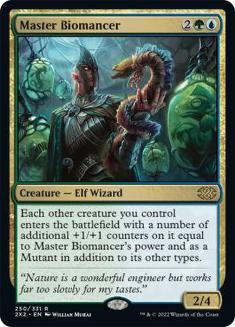
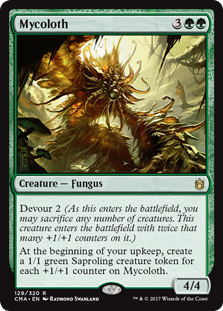
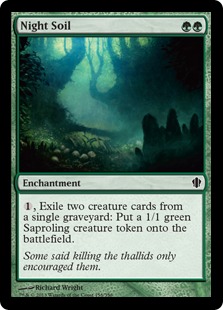
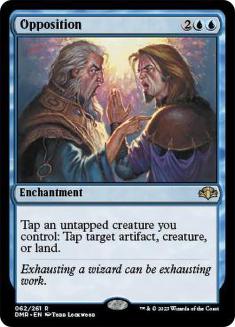
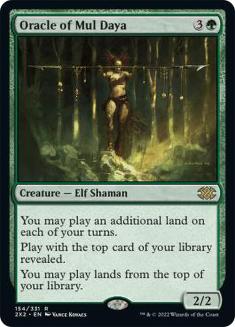
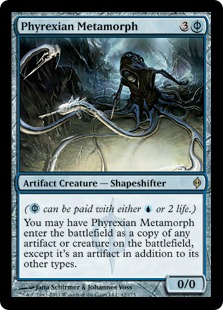
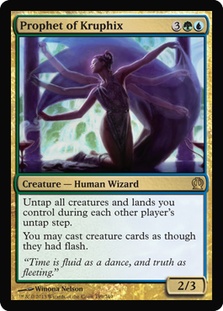
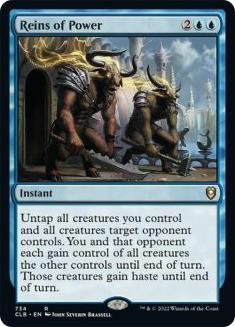
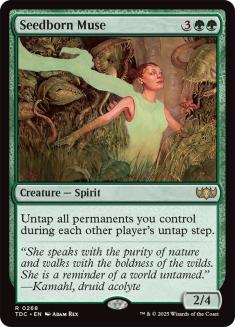
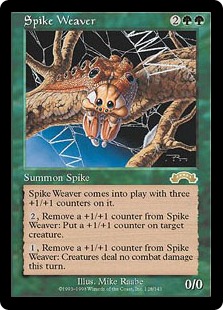
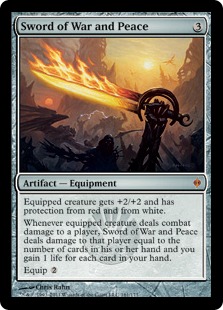

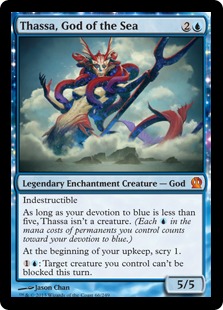
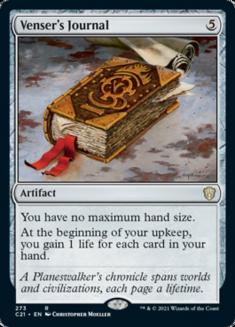
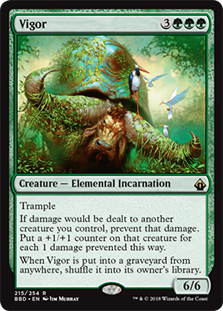
I’ll talk more in a future episode about my plans to update the Ezuri, Claw of Progress deck. It looks like it’s fun to play right out of the box, so I’m not too worried at the moment about adding cards. I just want to get a few games under my belt.
From the solid straight-out-of-the-box play to the League tweaks that will give extra strategic value to our games, our Commander 2015 Mini-League is sure to be a winner—since in the end, we win by having fun.
This Week’s Deck Without Comment is Adun’s Toolbox:
Creatures (36)
- 1 Ink-Eyes, Servant of Oni
- 1 Solemn Simulacrum
- 1 Kiki-Jiki, Mirror Breaker
- 1 Kokusho, the Evening Star
- 1 Withered Wretch
- 1 Wood Elves
- 1 Genesis
- 1 Undead Gladiator
- 1 Eternal Witness
- 1 Molder Slug
- 1 Grave-Shell Scarab
- 1 Burning-Tree Shaman
- 1 Big Game Hunter
- 1 Masked Admirers
- 1 Shriekmaw
- 1 Fertilid
- 1 Acidic Slime
- 1 Butcher of Malakir
- 1 Terastodon
- 1 Massacre Wurm
- 1 Scavenging Ooze
- 1 Soul of the Harvest
- 1 Rubblehulk
- 1 Gruul Ragebeast
- 1 Zhur-Taa Druid
- 1 Shattergang Brothers
- 1 Eidolon of Blossoms
- 1 Grenzo, Dungeon Warden
- 1 Feldon of the Third Path
- 1 Flesh Carver
- 1 Swift Warkite
- 1 Zulaport Cutthroat
- 1 Corpse Augur
- 1 Matter Reshaper
- 1 Archfiend of Ifnir
- 1 The Scorpion God
Planeswalkers (2)
Lands (36)
- 1 Strip Mine
- 6 Forest
- 1 Karplusan Forest
- 3 Swamp
- 3 Mountain
- 1 Badlands
- 1 Darigaaz's Caldera
- 1 Tower of the Magistrate
- 1 Miren, the Moaning Well
- 1 Golgari Rot Farm
- 1 Overgrown Tomb
- 1 Gruul Turf
- 1 Skarrg, the Rage Pits
- 1 Stomping Ground
- 1 Blood Crypt
- 1 Terramorphic Expanse
- 1 Graven Cairns
- 1 Mosswort Bridge
- 1 Spinerock Knoll
- 1 Savage Lands
- 1 Reliquary Tower
- 1 Dragonskull Summit
- 1 Rootbound Crag
- 1 Kazandu Refuge
- 1 Bojuka Bog
- 1 Command Tower
- 1 Kessig Wolf Run
Spells (25)
- 1 Sol Ring
- 1 Goblin Bombardment
- 1 Rampant Growth
- 1 Kodama's Reach
- 1 Plague Wind
- 1 Oversold Cemetery
- 1 Decree of Pain
- 1 Compost
- 1 Victimize
- 1 Savage Beating
- 1 Insurrection
- 1 Survival of the Fittest
- 1 Greater Good
- 1 Pernicious Deed
- 1 Sudden Spoiling
- 1 Explore
- 1 Momentous Fall
- 1 Cultivate
- 1 Hunter's Insight
- 1 Feed the Pack
- 1 Dictate of Erebos
- 1 Bitter Revelation
- 1 Palace Siege
- 1 Descent of the Dragons
- 1 Lifecrafter's Bestiary

Check out our awesome Deck List Database for the last versions of all my decks:
ADUN’S TOOLBOX;
ANIMAR’S SWARM;
AURELIA GOES TO WAR;
CHILDREN of a LESSER GOD;
DEMONS OF KAALIA;
EREBOS and the HALLS OF THE DEAD;
GLISSA, GLISSA;
HELIOD, GOD OF ENCHANTMENTS;
DREAMING OF INTET;
FORGE OF PURPHOROS;
KARN, BEATDOWN GOLEM;
HALLOWEEN WITH KARADOR;
KARRTHUS, WHO RAINS FIRE FROM THE SKY;
KRESH INTO THE RED ZONE;
LAVINIA BLINKS;
LAZAV, SHAPESHIFTING MASTERMIND;
ZOMBIES OF TRESSERHORN;
MELEK’S MOLTEN MIND GRIND;
MERIEKE’S ESPER CONTROL;
THE MILL-MEOPLASM;
MIMEOPLASM DO-OVER;
NATH of the VALUE LEAF;
NYLEA OF THE WOODLAND REALM;
OBZEDAT, GHOST KILLER;
PURPLE HIPPOS and MARO SORCERERS;
ZEGANA and a DICE BAG;
RITH’S TOKENS;
YOU DID THIS TO YOURSELF;
RURIC THAR AND HIS BEASTLY FIGHT CLUB;
THASSA, GOD OF MERFOLK;
THE ALTAR of THRAXIMUNDAR;
TROSTANI and HER ANGELS;
THE THREAT OF YASOVA;
RUHAN DO-OVER;
KARADOR DO-OVER;
KARRTHUS DO-OVER
If you’d like to follow the adventures of my Monday Night RPG group (in a campaign that’s been alive since 1987 and is just now getting started with a new saga called “The Lost Cities of Nevinor”), ask for an invitation to the Facebook group “Sheldon Menery’s Monday Night Gamers.”

